Mindfulness can transform your graphic design process, boosting creativity and focus. By staying present and aware, you enhance your decision-making and empathize with user needs. Techniques like meditation and mindful breathing help reduce stress, while mindful movement can spark new ideas. You’ll cultivate a healthier work environment and strengthen collaboration with others. As you explore these practices, you’ll discover even deeper insights and strategies to integrate mindfulness into your design work.
Key Takeaways
- Mindfulness enhances creativity by promoting cognitive flexibility and divergent thinking, allowing graphic designers to approach challenges from varied perspectives.
- Techniques like meditation and mindful breathing can reduce stress, improve focus, and enhance decision-making abilities in design processes.
- Deep listening fosters empathy, helping designers better understand user needs and create more resonant, user-centered designs.
- Integrating mindful movement into daily routines stimulates creativity and boosts energy levels, improving overall productivity in graphic design work.
- Practicing gratitude enhances overall well-being, encourages a positive mindset, and strengthens community support among graphic designers.
Understanding Mindfulness in Design

While you navigate the creative landscape of graphic design, understanding mindfulness can significantly enhance your process.
Mindfulness means paying attention on purpose, in the present moment, without judgment. By embracing this practice, you’ll feel more grounded and creative, reducing stress while increasing focus.
Incorporating mindfulness into your design process allows you to approach challenges with a beginner’s mindset, fostering openness and receptivity. This can enhance your perception and appreciation of the world around you, especially when influenced by cultural and environmental experiences.
Engaging in mindfulness helps you connect emotionally with your work, bridging personal expression and functional solutions. Additionally, practicing mindfulness can lead to improved cognitive performance, enabling you to generate innovative ideas and solutions in your designs.
Ultimately, integrating mindfulness into your design practice can lead to more impactful and meaningful creations.
The Role of Mindfulness in Enhancing Creativity
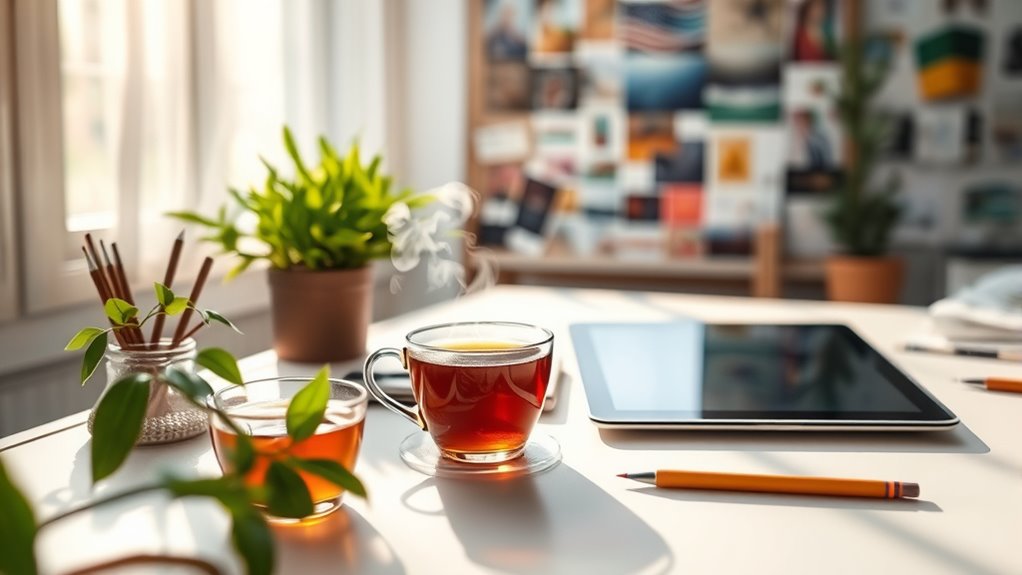
Mindfulness not only grounds your design process but also plays a pivotal role in enhancing your creativity. By promoting cognitive flexibility, mindfulness allows you to approach challenges from various angles, generating fresh ideas essential for innovative design.
It supports divergent thinking, encouraging you to brainstorm freely without the weight of judgment, fostering an environment where creativity can flourish. As you reduce stress and anxiety through mindfulness practices, you maintain clarity and focus, vital for effective problem-solving.
Additionally, mindfulness enhances your ability to notice subtle details and form novel connections, leading to creative breakthroughs. Integrating simple mindfulness exercises into your workflow can significantly elevate your creative potential, making your designs more impactful and resonant with your audience. Embracing meaningful experiences can further enrich your design journey by fostering deeper connections with your work and audience.
Key Benefits of Mindfulness for Graphic Designers
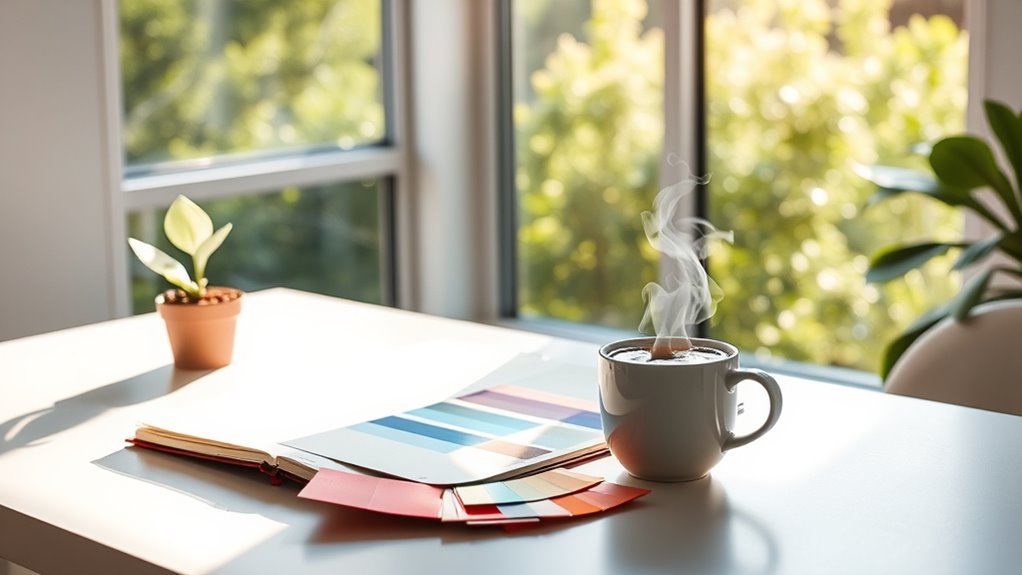
Graphic designers can significantly benefit from incorporating mindfulness into their daily practices. By enhancing decision-making, mindfulness helps you balance intuition with intellect, allowing for quicker and higher-quality choices.
It fosters empathy, crucial for understanding your audience’s needs and creating user-centered designs. Additionally, mindfulness reduces stress and anxiety, promoting a healthier work environment.
It encourages improved collaboration through active listening and non-judgmental communication, strengthening team dynamics. Embracing a holistic design approach, mindfulness integrates problem-solving with personal expression, enriching your creative process.
Ultimately, these benefits lead to a more fulfilling and productive design experience, empowering you to produce work that truly resonates with users while nurturing your well-being.
Mindfulness Techniques to Boost Focus and Clarity

To boost focus and clarity in your design work, incorporating mindfulness techniques can be a game changer. Start with regular meditation to calm your mind and reduce stress, enhancing your concentration.
Try walking meditation; as you walk, focus on your surroundings to elevate your awareness. Engage in the five senses exercise, noticing sights, sounds, and sensations to anchor yourself in the present.
Mindful drawing allows you to create without judgment, sparking creativity. Incorporate deep breathing techniques to maintain focus and alleviate anxiety during design tasks.
Tailoring Mindfulness Practices to Learning Preferences
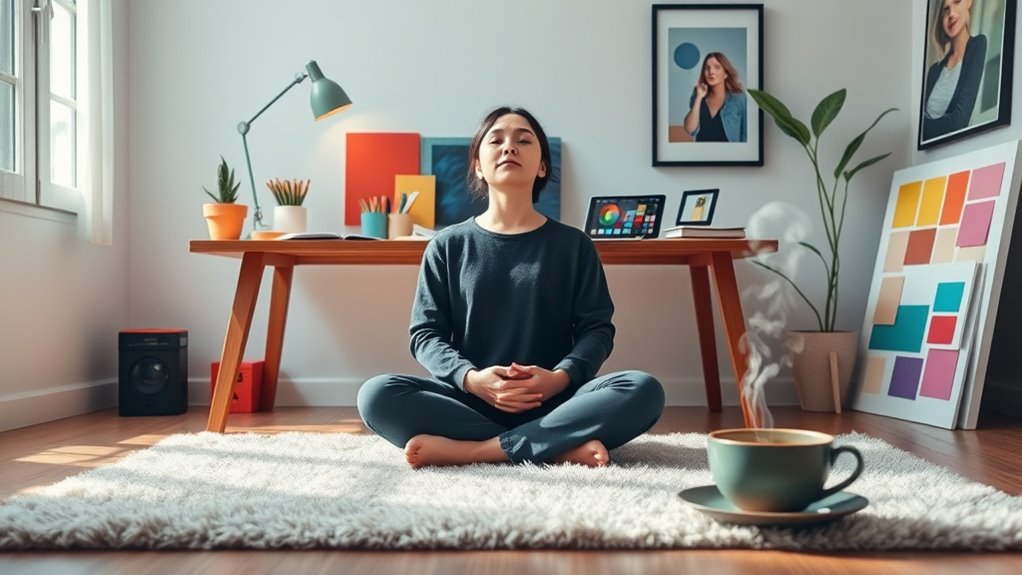
Incorporating mindfulness into your design practice can be even more impactful when you tailor these techniques to your unique learning preferences.
Whether you learn best through visual, auditory, or kinesthetic methods, adapting mindfulness practices can enhance your observational skills and cognitive flexibility.
For instance, if you’re a visual learner, try engaging with mindful imagery or sketching your thoughts to boost creativity.
Auditory learners might benefit from guided meditations or mindful music sessions.
Kinesthetic learners can practice mindfulness through movement, such as yoga or mindful walking.
Integrating Mindfulness in Design Education
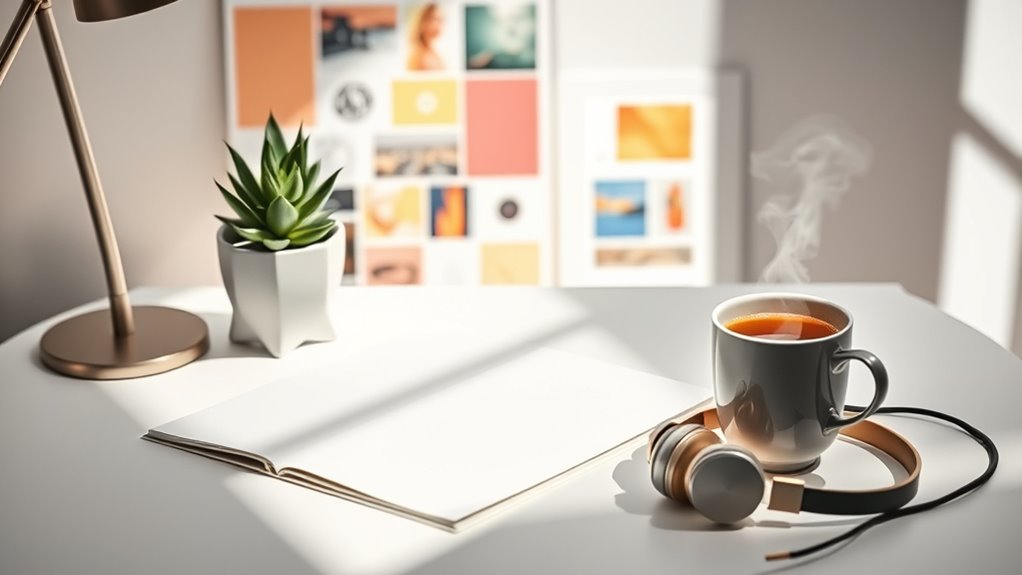
While integrating mindfulness into design education may seem challenging, doing so can significantly enrich student experiences and outcomes.
By developing holistic pedagogical tools, you can create an environment that emphasizes mindfulness as a contemplative art. This approach enhances awareness and empathy, fostering creativity and reducing stress among students.
Incorporating reflective practices encourages deeper learning and improves design intelligence, while mindfulness-based applications promote innovative thinking.
Additionally, combining mindfulness with cultural immersion can enhance design perception and appreciation.
You’ll find that these practices not only improve student well-being but also cultivate a balanced approach to design, merging intuition with intellect.
Mindfulness as a Tool for Professional Development

Mindfulness isn’t just beneficial in educational settings; it also serves as a powerful tool for professional development in graphic design. By fostering an open and non-judgmental mindset, mindfulness enhances your creativity, allowing you to explore new ideas freely. Staying focused and aware helps you develop innovative solutions and improves your problem-solving skills.
Additionally, mindfulness reduces stress, which boosts productivity and creativity.
Moreover, it cultivates emotional intelligence by increasing empathy and self-awareness, essential for understanding user needs. You’ll manage your emotions better, leading to smoother collaborations.
Mindfulness also promotes a holistic approach to design, balancing the creative and practical aspects of projects. Ultimately, incorporating mindfulness into your routine can significantly elevate your professional growth and effectiveness as a designer.
Real-World Applications of Mindfulness in the Design Process
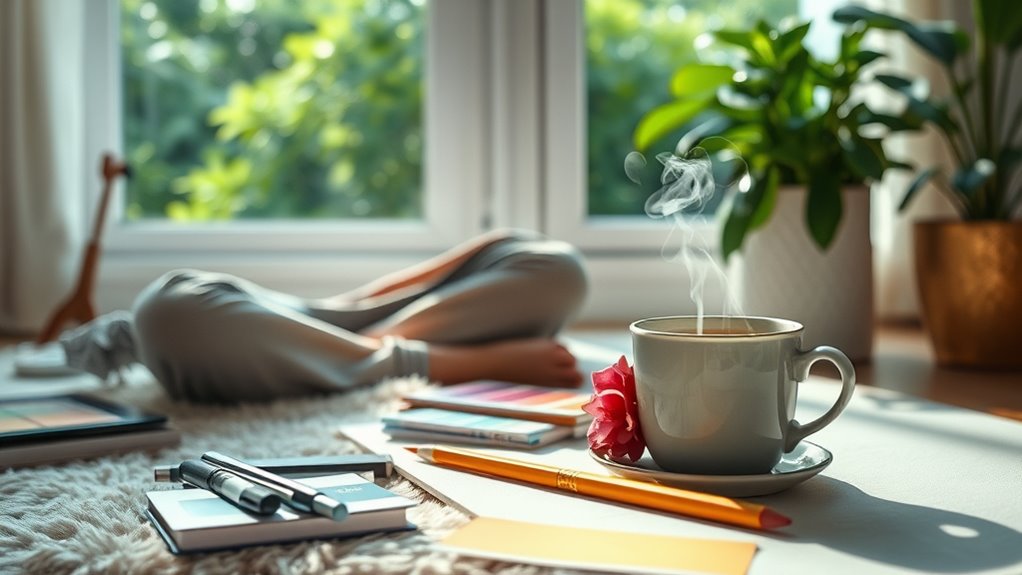
As you navigate the design process, applying mindfulness can transform your approach to creativity and problem-solving. By practicing mindfulness, you enhance your creativity, allowing fresh perspectives on challenges.
Improved focus reduces distractions, helping you stay present and efficient in your tasks. Mindfulness also fosters empathy, enabling a deeper understanding of user needs, which leads to more user-centric designs.
Managing stress through mindfulness techniques creates a healthier work environment, ultimately boosting productivity. By being more aware and intentional, you can make informed design choices that consider users and the environment. This holistic approach not only enhances your designs but also resonates with users, creating solutions that truly meet their emotional and functional needs. Furthermore, embracing failure as a stepping stone can lead to greater innovation in your design projects.
Building a Sustainable Mindfulness Practice in Design Work
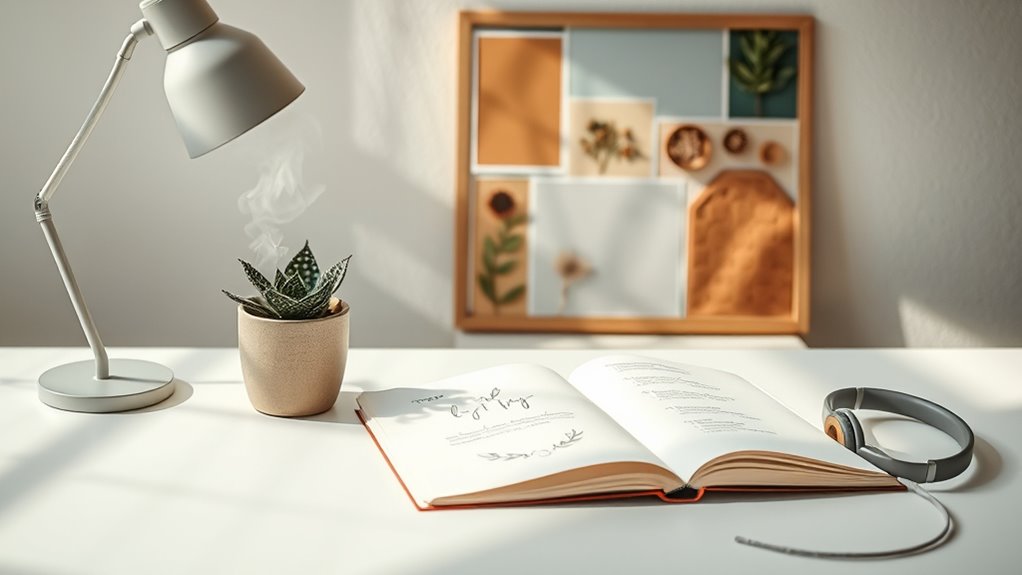
To cultivate a sustainable mindfulness practice in your design work, it’s essential to integrate simple yet effective techniques into your daily routine.
Start with daily meditation to enhance mental clarity and reduce stress, allowing for a more focused design process.
Adopt a beginner’s mindset to foster creativity and openness to new ideas.
Practice deep listening to better understand user needs and enhance empathy.
Make mindful breathing a habit, as it can improve your focus during complex tasks.
Incorporate mindful movement, like walking or yoga, to stimulate creativity.
Lastly, reflect on your resource usage to promote sustainability.
Additionally, engaging in gratitude practices can further increase your overall well-being and happiness, enriching your design experience.
Frequently Asked Questions
How Can Mindfulness Improve Client Relationships in Design Projects?
Mindfulness can significantly enhance your client relationships during design projects. By staying present, you’ll listen more attentively to feedback, fostering a collaborative environment.
It reduces stress, allowing you to engage with clients calmly and professionally. Practicing mindfulness also helps you set clear expectations, ensuring everyone’s on the same page.
Plus, it encourages empathy, enabling you to understand and address client concerns effectively, ultimately building trust and respect throughout the project.
What Are Some Common Misconceptions About Mindfulness in Design?
Imagine a pond, its surface smooth yet often rippled by misconceptions. You might think mindfulness means clearing your mind or sitting in silence, but it’s more about being present amid thoughts.
It doesn’t require hours; even a moment can be transformative. Many associate it with religion, yet it’s secular at its core.
Understand that mindfulness isn’t always about bliss; it’s about embracing the ebb and flow of creativity and focus in your design practice.
Can Mindfulness Practices Be Adapted for Remote Design Work?
Absolutely, you can adapt mindfulness practices for remote work.
Start by setting aside time for meditation or deep breathing during your day to clear your mind. Use apps to guide your practice, helping you stay focused and present.
Incorporate short mindful breaks to recharge, allowing yourself to step away from screens.
Regularly practicing gratitude can also enhance your overall well-being, making your remote work experience more fulfilling and productive.
How Do I Start a Mindfulness Practice as a Beginner Designer?
Imagine stepping into a serene garden, where every breath brings clarity.
To start your mindfulness practice, find a quiet spot and take a few minutes each day to breathe deeply. You don’t need fancy equipment; just your breath.
Try guided meditations on apps like Headspace. Embrace a beginner’s mindset—approach your thoughts with curiosity, not judgment.
Over time, you’ll cultivate awareness, enhancing both your creativity and focus as a designer.
What Resources Are Available for Learning Mindfulness Techniques?
To learn mindfulness techniques, you’ve got plenty of resources at your fingertips.
Websites like MindfulnessExercises.com offer comprehensive libraries filled with exercises. The Free Mindfulness Project provides guided meditations you can access for free.
You might also explore Mindfulness-Based Stress Reduction (MBSR) programs or delve into Positive Psychology for various techniques.
Books on mindfulness can deepen your understanding, and apps like Headspace or Calm can guide your practice daily.
Conclusion
Incorporating mindfulness into your graphic design practice can truly transform your creative process. By embracing techniques that enhance focus and clarity, you not only boost your productivity but also enrich your designs. Isn’t it time to explore how mindfulness can elevate your work and keep you grounded? As you build a sustainable mindfulness practice, you’ll find that your designs reflect not just skill, but a deeper connection to your creative vision.










